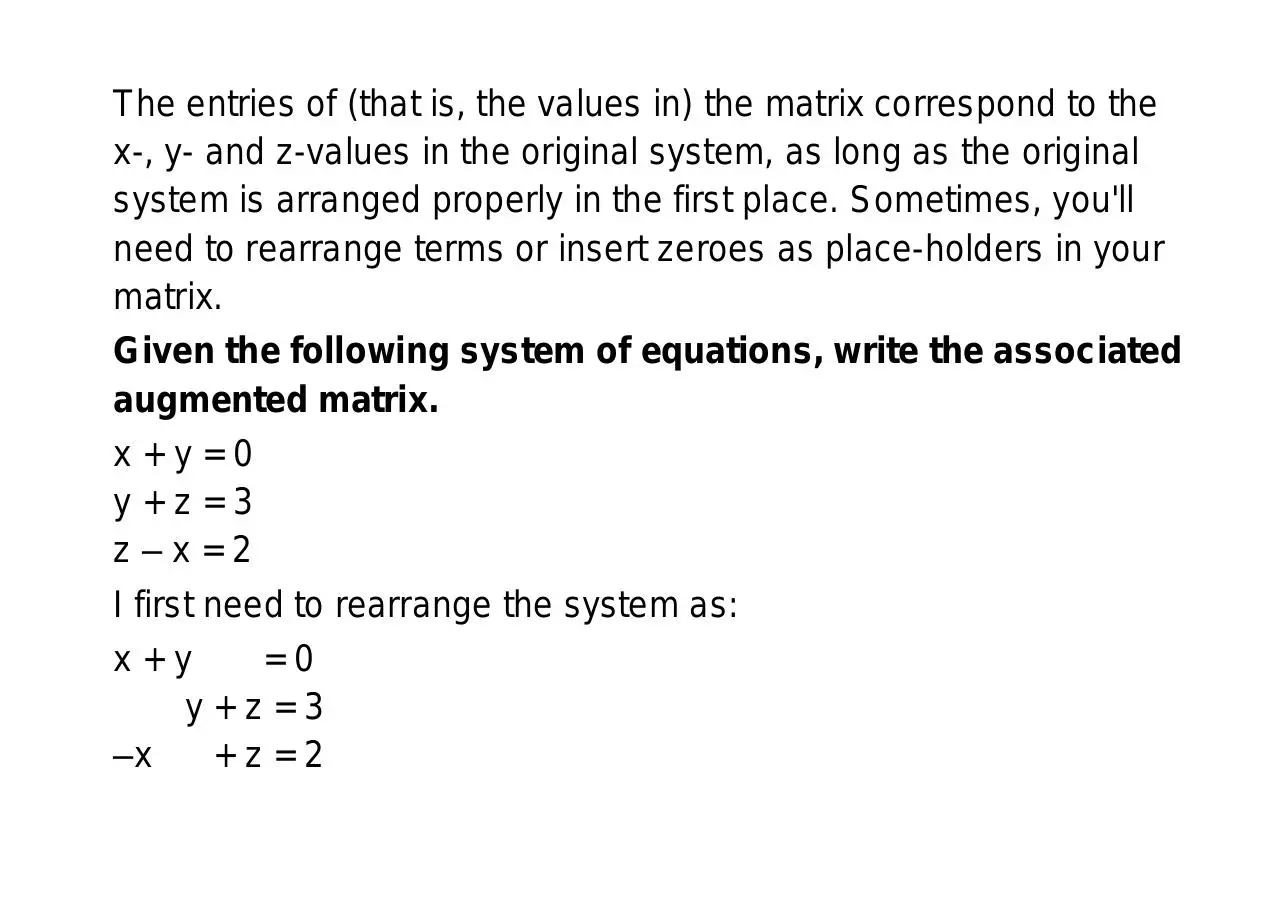Introduction to Matrices (PDF)
File information
Author: MMHADHOUD
This PDF 1.5 document has been generated by Microsoft® Word 2013, and has been sent on pdf-archive.com on 16/11/2015 at 20:19, from IP address 41.37.x.x.
The current document download page has been viewed 496 times.
File size: 1.13 MB (139 pages).
Privacy: public file





File preview
Lectures 4 - 5- 6
Chapter 2
Introduction to Matrices
Matrix Size
Augmented matrices
Matrices are incredibly useful things that crop up in many different
applied areas. For now, you'll probably only do some elementary
manipulations with matrices, and then you'll move on to the next
topic.
Matrices were initially based on systems of linear equations.
Given the following system of equations, write the associated
augmented matrix.
2x + 3y – z = 6
–x – y – z = 9
x + y + 6z = 0
Write down the coefficients and the answer values, including all
"minus" signs. If there is "no" coefficient, then the coefficient is "1".
That is, given a system of (linear) equations, you can relate to it
the matrix (the grid of numbers inside the brackets) which contains
only the coefficients of the linear system. This is called "an
augmented matrix": the grid containing the coefficients from the
left-hand side of each equation has been "augmented" with the
answers from the right-hand side of each equation.
The entries of (that is, the values in) the matrix correspond to the
x-, y- and z-values in the original system, as long as the original
system is arranged properly in the first place. Sometimes, you'll
need to rearrange terms or insert zeroes as place-holders in your
matrix.
Given the following system of equations, write the associated
augmented matrix.
x+y=0
y+z=3
z–x=2
I first need to rearrange the system as:
x+y
=0
y+z=3
–x
+z=2
Then I can write the associated matrix as:
When forming the augmented matrix, use a zero for any entry
where the corresponding spot in the system of linear equations is
blank.
Coefficient matrices
If you form the matrix only from the coefficient values, the matrix
would look like this:
This is called "the coefficient matrix". Copyright © Elizabeth
Stapel 2003-2011 All Rights Reserved
Above, we went from a linear system to an augmented matrix. You
can go the other way, too.
Given the following augmented matrix, write the associated
linear system.
Remember that matrices require that the variables be all lined up
nice and neat. And it is customary, when you have three variables,
to use x, y, and z, in that order. So the associated linear system
must be:
x + 3y
= 4
2y – z = 5
3x
+ z = –2
The Size of a matrix
Matrices are often referred to by their sizes. The size of a matrix is
given in the form of a dimension, much as a room might be
referred to as "a ten-by-twelve room". The dimensions for a matrix
are the rows and columns, rather than the width and length. For
instance, consider the following matrix A:
Since A has three rows and four columns, the size of A is 3 × 4
(pronounced as "three-by-four").
The rows go side to side; the columns go up and down. "Row" and
"column" are technical terms, and are not interchangable. Matrix
dimensions are always given with the number of rows first,
followed by the number of columns. Following this convention, the
following matrix B:
...is 2 × 3. If the matrix has the same number of rows as columns,
the matrix is said to be a "square" matrix. For instance, the
coefficient matrix from above:
...is a 3 × 3 square matrix.
Matrix Notation / Types of Matrices
Matrix Notation and Formatting
A note regarding formatting. When you write a matrix, you must
use brackets: " [ ] ". Do not use absolute-value bars: " | | ", as they
have a different meaning in this context. Do not use parentheses
or curly braces ( " { } " ) or some other grouping symbol (or no
grouping symbol at all), as these presentations have no meaning.
A matrix is always inside square brackets. Use the correct
notation, or your answers may be counted as incorrect.
As mentioned earlier, the values contained within a matrix are
called "entries". For whatever reason, matrixes are customarily
named with capital letters, such as "A" or "B", and the entries are
named using the corresponding lower-case letters, but with
subscripts. In a matrix A, the entries will typically be named "ai,j",
where "i" is the row of A and "j" is the column of A. For instance,
given the following matrix A:
Download Introduction to Matrices
Introduction to Matrices.pdf (PDF, 1.13 MB)
Download PDF
Share this file on social networks
Link to this page
Permanent link
Use the permanent link to the download page to share your document on Facebook, Twitter, LinkedIn, or directly with a contact by e-Mail, Messenger, Whatsapp, Line..
Short link
Use the short link to share your document on Twitter or by text message (SMS)
HTML Code
Copy the following HTML code to share your document on a Website or Blog
QR Code to this page

This file has been shared publicly by a user of PDF Archive.
Document ID: 0000315238.